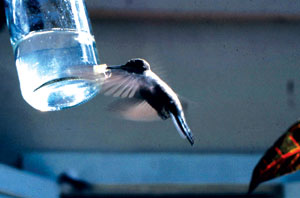






 |
 |

Rufous-Breasted Hermit Hummingbird
Caption:
This is rufous-breasted hermit hummingbird (Gluacis hirsute). The males and females have similar plumage. This species has a complex song, but timid behavior for a hummingbird. Here the bird is feeding at a sugar water bottle (24% sugar in sterile boiled water). It sticks its long tongue through its beak into the bottle (tongue not seen). It has a curved beak that fits into the curved flowers that it evolved to feed from. The feeder is on the porch area of the main museum office for the Natural Museum of Museu de Biologia Mello Leitão, Espírito Santo Brazil. NSF-supported researcher Dr. Erich Jarvis of Duke University is studying hummingbirds and their vocal structures. In 2002, Jarvis was awarded the Alan T. Waterman, NSF’s highest honor for researchers under the age of 35. [See related images: Swallow-Tailed Hummingbird and White Throated Hummingbird.]
More about this Image
Hummingbirds have developed a wealth of intriguing features, such as backwards flight, ultraviolet vision, extremely high metabolic rates, nocturnal hibernation, high brain-to-body size ratio, and a remarkable species-specific diversity of vocalizations. Like humans, they have also developed the rare trait of vocal learning, the ability to acquire vocalizations through imitation rather than instinct.
Vocal learning is a very rare trait. It is known to be present in only 6 groups of animals--3 groups of birds (parrots, songbirds, and hummingbirds) and 3 groups of mammals (bats, cetaceans [whales/dolphins], and humans). All other groups of animals are thought to produce genetically innate vocalizations. To understand this concept, it is important to distinguish vocal learning from auditory learning. Auditory learning is the ability to make sound associations, such as a dog learning how to respond to the sound "sit." All vertebrates have auditory learning. Vocal learning is the ability to imitate sounds that you hear, such as a human or a parrot imitating the sound "sit." Currently only vocal learners have been found to have forebrain regions dedicated to vocal learning and production of these learned vocalizations. Vocal non-learners only have been found to have non-forebrain vocal regions responsible for the production of innate vocalizations.
Dr. Erich Jarvis of Duke University is studying hummingbirds and their vocal structures. Hummingbirds are a particularly good model to study because they have the ability to imitate sounds and pass them down through generations. The objective of this project is to determine how the vocal learning behavioral trait and associated brain structures evolved.
We utilize vocalizing-driven gene expression to identify vocal brain structures in vocal learning and vocal non-learning species. To date, we have used this approach in 3 vocal learners - songbirds, parrots, and hummingbirds. We have found that they each contain 7 very similar brain structures. If according to the current dominant hypothesis, vocal learning evolved independently in all 6 vocal learning groups within the past 65 million years, then the striking similarities in brain structures of at least the 3 avian groups suggest that there a strong epigenetic constraints on how vocal learning can evolve. We are now determining if this hypothesis is correct, or if there really was a common ancestor with vocal learning, and other groups lost them through evolution.

(Preview Only)

|
| Credit: |
Picture by Maria Amelia for Dr. Erich D. Jarvis |
| Decade of Image: |
2000 - 2009 |
|
Categories:
ANIMALS / BIRDS / REPTILES / FISH
BEHAVIORAL / Neuro, Cognitive
Formats Available:
Restrictions:
Important: Permission is granted to use this image for personal, educational, or nonprofit/non-commercial purposes only.
|